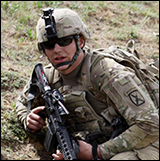
| USA ARMY BRIGADES |
| USA KOPNENA VOJSKA - BRIGADE |
|
|
|
Reorganizacija Nacionalne garde zahvatila je dio jedinica. Neke jedinice su preimenovane ili deaktivirane. Nekima su podređene jedinice preraspoređene u druge komande. |
||
|
Several units have been affected by Army National Guard reorganizations. Some have been renamed or inactivated. Some have had subordinate units reallocated to other commands. |
||
|
18th AVIATION BRIGADE 18. AVIJACIJSKA BRIGADA |
||
 |
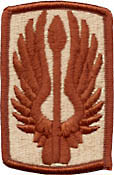 |
|
|
26th INFANTRY BRIGADE 26. PJEŠADIJSKA BRIGADA |
||
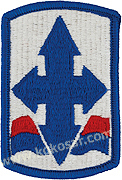 |
||
|
36th INFANTRY BRIGADE 36. PJEŠADIJSKA BRIGADA |
||
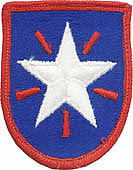 |
||
|
On a blue shield rounded at base within a 1/8 inch (.32cm) red border 2 1/4 inches (5.72cm) in width overall, a white five-pointed star with a detached and tapered red ray between and within each of the points. The white star on a blue field was suggested by the first official flag of the Republic of Texas adopted in May 1836 from the design of Lorenzo de Zavala, a native of San Antonio, Texas. To this has been added red rays which allude to the courage of all Texans who have fought gallantly in all wars since 1826, and a red border which refers to the blood shed in protecting not only the liberties of the United States but the liberties of all. |
||
|
39th INFANTRY BRIGADE 39. PJEŠADIJSKA BRIGADA |
||
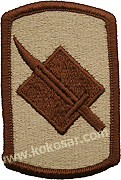 |
||
|
The unit's shoulder sleeve insignia consists of a Bowie knife over a diamond. The Bowie knife symbolizes the state of Arkansas, where the Bowie knife originated, and close hand-to-hand fighting which is the specialty of the light infantry. The diamond is a reference to a unique aspect of the state of Arkansas which has the only diamond field in North America in Murfreesboro, Arkansas. The red and blue colors are the colors of the Arkansas flag and represent both their loyalty (blue) and the blood (red) that its soldiers have shed for both the state of Arkansas, and the United States in its operations. The brigade motto is "Courage". The ultimate symbol of the 39th Brigade Combat Team is the Bowie knife that adorns the brigade patch and is worn by certain Field Grade Officers and Command Sergeants Major in the brigade. |
||
|
48th INFANTRY BRIGADE 48. PJEŠADIJSKA BRIGADA |
||
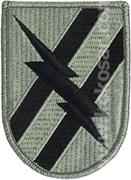 |
||
|
67th INFANTRY BRIGADE 67. PJEŠADIJSKA BRIGADA |
||
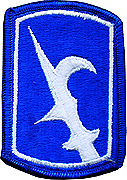 |
||
|
86th INFANTRY BRIGADE 86. PJEŠADIJSKA BRIGADA |
||
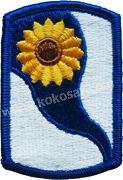 |
||
|
116th INFANTRY BRIGADE 116. PJEŠADIJSKA BRIGADA |
||
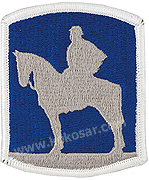 |
||
|
The 116th Infantry Brigade Combat Team was formerly known as the 1st Brigade, 29th Infantry Division. It is currently assigned to the Virginia Army National Guard. The Brigade is headquartered in Staunton, Virginia. During the Second World War, the 116th Infantry Regiment took part in the Invasion of Normandy. The regiment suffered 314 casualties, including soldiers from A Company, which lost 96% of their men within the first 10 minutes of landing on Omaha Beach. During a move from Les Moulins, the 2nd Battalion broke loose from the beach and fought their way to a farmhouse to become the first command post in France. In January 2010, the first battalion mobilized with the Louisiana National Guard's 256th IBCT to Iraq to conduct convoy security missions in southern Iraq, known as TF Overlord, a tribute the unit's D-Day heritage. |
||
|
On an oblong shield curved at top and bottom, 2 1/2 inches 6.35 cm) in width and 3 inches (7.62 cm) in height overall, a gray silhouette representative of the Stonewall Jackson Monument at Manassas Battlefield Park, Virginia, on a blue background all within a 1/8 inch (.32 cm) white border. The equestrian figure is a representation of the General Thomas J. Jackson Monument at Manassas where he gained the nickname “Stonewall.” The colors blue and gray refer to the rich heritage of the state of Virginia and blue and white are the colors associated with the Infantry Branch. The shoulder sleeve insignia was originally approved for the 116th Infantry Brigade on 26 May 1978. |
||
|
171st INFANTRY BRIGADE 171. PJEŠADIJSKA BRIGADA |
||
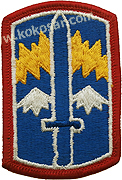 |
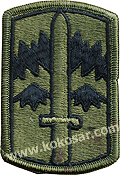 |
|
|
The 171st Infantry Brigade is an infantry brigade of the United States Army based in Fort Jackson, South Carolina. With a long history of serving, the Brigade saw action during both World War I andWorld War II before it was inactivated in 1946. During the Cold War (in 1962) the brigade was once again activated for a period of ten years until again inactivated in 1972. In 2007 the brigade was reactivated as a training support unit. |
||
|
173rd AIRBORNE BRIGADE 173. PADOBRANSKA BRIGADA |
||
|
Na plavom cilindru visine 7,6 cm i širokom 5,1 cm obrubljenim tri milimetra širokim bjelim rubom verikalno je postavlejno krilo u letu. Donji dio krila je produžen i pridržava crvenu bajonetu. Iznad ove se oznake nosi i plava lenta sa bjelim slovima ispisano AIRBORNE. Bajoneta i krilo „govore“ da je brigada rođena iz vjetra, što aludira na njen padobranski status. Crveno, bjelo i plavo su nacionalne boje. Oznaka je odobrena 13. 05. 1963. godine. |
||
 |
 |
|
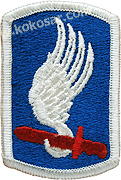 |
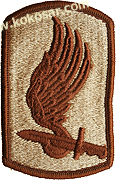 |
|
|
On a blue silhouetted right cylinder 3 inches (7.62 cm) in height and 2 inches (5.08 cm) in width overall within a 1/8 inch (.32 cm) white border a vertical white wing in flight, the ulna (lower end) extended and hooked around a red bayonet. Attached above the insignia is a blue tab inscribed "AIRBORNE" in white. The bayonet is used to refer to the brigade being borne by the wing alludes to the brigade's airborne status. Red, white and blue are the national colors. The shoulder sleeve insignia was originally approved on 13 May 1963. |
||
|
187th INFANTRY BRIGADE 187. PJEŠADIJSKA BRIGADA |
||
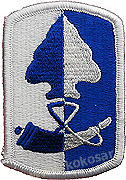 |
||
|
The 187th Infantry Brigade was aninfantry brigade of the United States Army. It was first formed under the United States Army Reserve's 94th Army Reserve Command, which wore the patch of the inactivated )$th Infantry Division, from which the 187th was formed when the 94th was inactivated and the combat element reduced to brigade size. As a separate brigade, the 187th wore its own shoulder patch. It served from 1963 through 1994, when it was inactivated as part of the Army-wide post-Cold War drawdown. Cold War plans called for the Brigade to deploy to Iceland as part of the Iceland Defense Force if a confrontation between NATO and the Soviet Union eventuated. |
||
|
193rd INFANTRY BRIGADE 193. PJEŠADIJSKA BRIGADA |
||
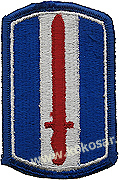 |
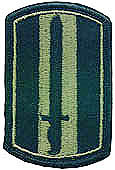 |
|
|
A silhouetted right cylinder 3 inches (7.62 cm) in height and 2 inches (5.08 cm) in width. Within a 1/8 inch (.32 cm) blue border fimbriated by a 1/16 inch (.16 cm) white inner edge, on a blue field a white serrated vertical band 1 3/32 inches (2.78 cm) in width charged with a red cartridge 2 5/8 inches (6.67 cm) in height. Blue and white are the colors used for Infantry. The serrated section is symbolic of close combat and counterattack abilities. The cartridge alludes to the unit’s capabilities of destroying the enemy and repelling his assault with fire powers. Red, the most powerful color of the spectrum, represents the striking power of the unit. The shoulder sleeve insignia was approved on 14 December 1962. |
||
|
196th INFANTRY BRIGADE 196. PJEŠADIJSKA BRIGADA |
||
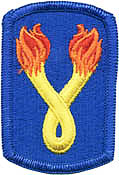 |
||
|
The 196th Infantry Brigade ("Chargers") , also known as the Charger Brigade was first formed on 24 June 1921 as part of the United States Army Reserve's 98th Division with the responsibility of training soldiers. On 26 May 1998, the 196th was reactivated during a ceremony at Fort Shafter, Hawaii. The new brigade assists reserve units in Hawaii, Alaska, Guam, American Samoa, and Japan, as a Training Support Brigade, providing support to Reserve Component Forces throughout the Pacific area. |
||
|
197th INFANTRY BRIGADE 197. PJEŠADIJSKA BRIGADA |
||
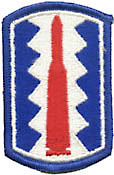 |
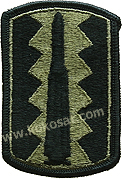 |
|
|
The 197th Infantry Brigade ("Follow Me") is an Infantry brigade of the United States Army. Currently, the Brigade is garrisoned at Fort Benning, GA as part of TRADOC. The Brigade's mission is to "access and train Soldiers and Infantry leaders, demonstrate Infantry tactics, provide subject matter expertise, develop doctrine and support the USAIS in order to provide the army with soldiers and leaders prepared to fight and win." |
||
|
199th INFANTRY BRIGADE 199. PJEŠADIJSKA BRIGADA |
||
|
Na plavom štitu zaobljenih krajeva visine 7,62 cm i 5.08 cm širine, obrubljenim plavim rubom od 0.32 cm i unutrašnjim bijelim rubom širine 0.16 cm položeno je bijelo koplje, sa šiljkom okrenutim prema gore. Okolo koplja se šire palmen žute boje sa crvenim plamenom u sredini. Plava i bijela boja su boje pješadije. Koplje u plamenu, rano pješadijsko oružje, simbolizira evoluciju i vatrenu moć moderne pješadije. Oznaka za rukav je odobrena 10. 06. 1966. godine. |
||
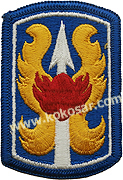 |
||
|
On a shield, oblong in shape and arched at both ends, 3 inches (7.62 cm) in height and 2 inches (5.08 cm) in width overall, edged with a 1/8 inch (.32 cm) blue border fimbriated by a 1/16 inch (.16 cm) white inner edge on a blue background, the upper length of a white spear, the area below the spearhead enveloped with a stylized yellow flame having an inner core of red. The colors blue and white are used for Infantry. The spear, an early Infantry weapon in flames, symbolizes the evolution and firepower of the modern Infantry. The shoulder sleeve insignia was approved on 10 June 1966. |
||
|
205th INFANTRY BRIGADE 205. PJEŠADIJSKA BRIGADA |
||
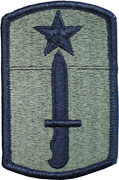 |
||
|
The 205th Infantry Brigade, was first formed as part of the United States Army Reserve's 103rd Division. It was active from 1921 to 1942 and then from 1963 through 1994, and then reformed in 2006. It was initially formed within the Organized Reserve Corps in Arizona and New Mexico, including the 409th and 410th Regiments. Its sister brigade within the 103rd Division was the 206th Brigade in Colorado, which included the 411th and 412th Regiments. |
||
|
218th INFANTRY BRIGADE 218. PJEŠADIJSKA BRIGADA |
||
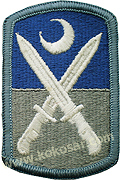 |
 |
|
| LIAISON AND MONITORING TEAM | ||
| KFOR - Tim za vezu i nadzor | ||
|
244th AVIATION BRIGADE 244. AVIJACIJSKA BRIGADA |
||
 |
||
|
A rectangle arced at the top and bottom with a 1/8 inch (.32 cm) ultramarine blue border 2 inches (5.08 cm) in width and 3 inches (7.62 cm) in height overall divided horizontally embattled golden orange and ultramarine blue bearing a black hawk's head at top and a white stylized compass rose at bottom. Ultramarine blue and golden orange are the colors traditionally used by Aviation units. The stylized compass rose/polestar symbolizes guidance, directions, and leadership. The hawk symbolizes vigilance and strike capabilities as well as flight and power in reserve. The shoulder sleeve insignia was approved on 1 August 1995. |
||
|
502nd INFANTRY BRIGADE 502. PJEŠADIJSKA BRIGADA |
||
|
502. pješadijska padobranska regimenta (502nd Parachute Infantry Regiment 502nd PIR) je osnovana za vrijeme Drugog svjetskog rata, kao dio 101. Padobranske divizije (101st Airborne Division) Kopnene vojske SAD-a. Regimenta je imala značajna ratna djelovanja tokom 2SR-a, kasnije je učetvovala u Vijetnamskom ratu, Prvom golfskom ratu, Operaciji „Iračka sloboda“ kao i u operaciji „Održiva sloboda“ u Afganistanu. Od 1974. godine, regimenta je klasificirana kao padobranska pješadija i trenutno njena dva bataljona služe pod komandom Borbenog tima 2. brigade 101. Padobranske divizije. |
||
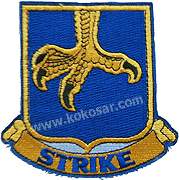 |
||
|
The 502nd Parachute Infantry Regiment (502nd PIR) was established during World War II as a regiment of the 101st Airborne Division of the United States Army. The regiment saw substantial action in World War II and later went on to deploy in the Vietnam War, the first Gulf War, Operation Iragi Freedom, and Operation Enduring Freedom in Afghanistan. Since 1974, the regiments has been classified as air assault infantry, and at present, the regiment's two battalions are under the command of the 2nd Brigade Combat Team, 101st Airborne Division. |
||
|
A gold color metal and enamel device 1 1/8 inches (2.86cm) in height overall consisting of a shield blazoned: Azure, issuant from chief, an eagle's claw, talons extended Or, armed Sable. Attached below the shield a gold motto scroll inscribed "STRIKE" in blue letters. The blue is for Infantry. The grasping eagle's claw is a representation of the airborne functions of the organization. The motto is expressive of the power of the organization. The distinctive unit insignia was originally approved for the 502d Parachute Infantry Regiment on 14 Nov 1942. On 14 Feb 1958 the insignia was redesignated for the 502d Infantry. |
||
|
|
||
| American military patch guide, J.L. Pete Morgan and Ted A. Thurman, 1997 | ||
|
Complete guide to the United States Army Medals, Badges and Insignia World War II to present, Cl. Frank C. Foster, 2004 |
||
|
ON TOP
|
||





